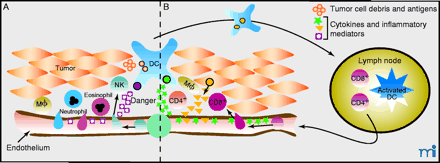
- Institution: Stanford Univ Med Ctr Lane Med Lib/Periodical Dept/Rm L109
- Sign In as Member / Individual
Discovery of an Innate Cancer Resistance Gene?

A revised model of cancer immune surveillance. The initial event in priming the immune system to cellular transformation likely consists of a specific danger/alert signature caused by cellular transformation in the context of its surrounding tissue microenvironment. This signature change in the microenvironment may manifest itself as alterations in regulatory cytokines and chemokines produced by tissue cells, the leukocytes with the tissue, and the endothelium supplying nutrients to the tissue. The subsequent immune response to this signature will depend upon the nature of the host cell transformed and transformation process itself. This resulting immune response may be entirely innate (A) or additionally involve components of the adaptive immune response (B). Tissue dendritic cells will likely be central to either type of basic response by virtue of their ability to capture antigen, receive signals through their pattern recognition receptors, and commence crosstalk with other cells in the tissue. Innate responses may include the recruitment of various leukocytes including NK cells, macrophages, and granulocytes (i.e., neutrophils and eosinophils). These events may be sufficiently amplified to control transformation and eliminate the tumor mass by immunological and non-immunological (e.g., vasculature) mechanisms. In other instances, and by as yet undefined molecular cues, dendritic cells within the transformed tissue will be activated and migrate to draining lymph nodes where they will provoke responsiveness of the adaptive immune system including CD4+ and CD8+ T cells. Activated T cells specific for tumor then make their way along a chemokine gradient to the site of tumor growth where they engage in MHC-restricted elimination of tumor cells.


